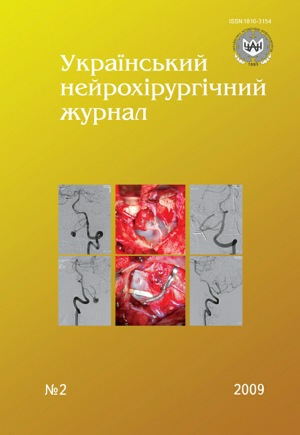Results of hydrocephalus surgical treatment, caused by perinatal brain injury, at children
DOI:
https://doi.org/10.25305/unj.108642Keywords:
perinatal brain injury, posthemorrhagic hydrocephalus, shunting operationsAbstract
The surgical treatment results of 237 children with progressive hydrocephalus, caused by perinatal brain injury, were analyzed. The rational surgical tactics at progressive hydrocephalus was developed and applied that provided decrease of malfunctions frequency of the shunt systems from 21,9 to 9,4%, infectious-inflammatory complications — from 18,2 to 10,7%, mortality — from 8,2 to 1,5%. The program complex for prediction of hydrocephalus outcomes, caused by perinatal brain injury, was offered and quantitative evaluation of prognostic factors was made.
References
Берснев В.П., Телегина А.А, Хачатрян В.А. К вопросу о диагностических возможностях гидроцефалии у детей // Материалы конф. «Современные методы диагностики и лечения заболеваний нервной системы». — Уфа, 1996. — Ч.II. — С.150–151.
Бродский Ю.С., Вахата Я.Я. Гидроцефалия у детей, перенесших родовую черепно-мозговую травму // Нейрохирургия. — 1989. — Вып. 22. — С.52–56.
Гидроцефалия (патогенез, диагностика, хирургическое лечение) / В.А. Хачатрян, Ш.М. Сафин, Ю.А. Орлов, Т.Н. Трофимова. — СПб.: Изд-во РНХИ им. проф. А.Л. Поленова, 1998. — 234 с.
Зиненко Д.Ю., Мытников А.М., Ермолаев Т.П., Владимиров М.Ю. Лечение недоношенных детей с постгеморрагической гидроцефалией // Нейрохирургия и неврология дет. возраста. — 2004. —№3. — С.39–45.
Коновалов А.Н., Корниенко В.Н., Пронин И.Н. Магниторезонансная томография в нейрохирургии. — М.: Видар, 1997. — 472 с.
Лечебно-диагностические технологии и методы прогнозирования исходов перинатальных повреждений центральной нервной системы: Метод. рекомендации / С.П. Катонина, Е.Г. Сулима, Е.А. Макарова и др. — К., 1995. — 30 с.
Неотложная неврологическая помощь в детском возрасте / Под ред. Дж.М. Пеллона, Э.К. Майера: пер. с англ. — М.: Медицина, 1988. — 578 с.
Орлов Ю.А. Гидроцефалия. — К.: Здоров’я, 1995. — 87 с.
Орлов Ю.А. Оценка качества жизни пациентов с поражениями центральной нервной системы // Укр. нейрохірург. журн. — 2001. — №1. — С.89–94.
Орлов Ю.А. Касьянов В.А. Дифференцированное лечение перинатального внутричерепного кровоизлияния у новорожденных // Укр. нейрохірург. журн. — 2008. — №1. — С.50–52.
Орлов Ю.О., Марущенко Л.Л., Шаверський А.В. Нейрохірургічні аспекти лікування внутрішньочерепних нетравматичних крововиливів у новонароджених // Соціальна педіатрія: Зб. наук. праць. — К.: Інтермед, 2005. — Вип. ІІІ. — С.123–126.
Орлов Ю.О., Проценко І.П., Марущенко Л.Л. Якість життя дітей з гідроцефалією, оперованих в грудному віці // Соціальная педіатрія і реабілітологія: Зб. наук. праць. — К.: Інтермед, 2007. — Вип. І (IV). — С.84–89.
Сафин Ш. Н., Валеева К. Г., Сафин Ш. А. и др. Новые технологии в нейрохирургии гидроцефалии // Нейрохирургия. — 2000. — №1–2. — С.73.
Симерницкий Б.П. Хирургическое лечение гидроцефалии у детей при помощи имплантируемых дренажных систем: Автореф. дис. … д-ра мед. наук: 14.00.28; НИИ нейрохирурги им. Н.Н. Бурденко. — М., 1989. — 17 с.
Хачатрян В.А. К проблеме «Классификация гидроцефалии» // Нейрохирургия. — 2000. — №1–2. — С.69.
Antoniuk S., du Silva R.V. Periventricular and intraventricular hemorrhage in the premature infants // Rev. Neurol. — 2000. —V.31, N3. — P.238–243.
Brouwer A., Groenendaal F., van Haastert I.L. et al. Neurodevelopmental outcome of preterm infants with severe intraventricular hemorrhage and therapy for post-hemorrhagic ventricular dilatation // J. Pediatrics. — 2008. — V.152, N5. — Р.648–654.
Drake J., Kestle J., Milner R. et al. Randomized trial of cerebrofluid shunt valve desing in pediatric hydrocephalus // Neurosurgery. — 1998. — V.43, N2. — P.294–303.
el Awad M.E. Infantile hydrocephalus in the south-western region of Soudi Arabia // Ann. Trop. Paediatr. — 1992. — V.12, N3. — P.335–338.
Farnell E., Hadberg G. Infantile hydrocephalus: declining prevalence in preterm infants // Acta Paediatr. — 1998. — V.87, N4. — Р.392–396.
Fletcher G.M., Landry S.H., Bohan T.P. et al. Effects of intraventricular hemorrhage and hydrocephalus on the long-term neurobehavioral development of preterm very-low-birth weight infants // Dev. Med. Child. Neurol. — 1997. — V.39, N9. — P.596–606.
Futagi Y., Suzuki Y., Toribe Y. et al. Neurodevelopmental outcome in children with posthemorrhagic hydrocephalus // Pediatr. Neurol. — 2005. — V.33, N1. — Р.26–32.
Kazan S., Gra A., Uar T. et al. Hydrocephalus after intraventricular hemorrhage in preterm and low-birth weight infants: analysis of associated risk factors for ventriculoperitoneal shunting // Surg. Neurol. — 2005. — V.64, suppl.2. — P.77–81.
Owens R. Intraventricular hemorrhage in the premature neonate // Neonat. Netw. — 2005. — V.24, N3. — Р.55–71.
Downloads
Published
How to Cite
Issue
Section
License
Copyright (c) 2009 Yu. A. Orlov, L. L. Marushchenko, I. P. Protsenko

This work is licensed under a Creative Commons Attribution 4.0 International License.
Ukrainian Neurosurgical Journal abides by the CREATIVE COMMONS copyright rights and permissions for open access journals.
Authors, who are published in this Journal, agree to the following conditions:
1. The authors reserve the right to authorship of the work and pass the first publication right of this work to the Journal under the terms of Creative Commons Attribution License, which allows others to freely distribute the published research with the obligatory reference to the authors of the original work and the first publication of the work in this Journal.
2. The authors have the right to conclude separate supplement agreements that relate to non-exclusive work distribution in the form of which it has been published by the Journal (for example, to upload the work to the online storage of the Journal or publish it as part of a monograph), provided that the reference to the first publication of the work in this Journal is included.









